Check out my custom vibration dampener
A Complete Overview of The Eastern Forehand Grip
With a Helpful Diagram
While not as popular as it once was, the eastern grip is among the three most common tennis grips used by recreational and professional players.
In this article, we’ll take a look at the eastern forehand grip in detail and explore the pros and cons of using this particular grip.
Article Contents
Click below to jump to a section
Tap below to jump to a section
Eastern Forehand Grip
Holding an Eastern Grip
Benefits
Drawbacks
Using an Eastern Grip
Wrapping Up
New to TennisCompanion?
Create a free account and explore my latest videos below
The Eastern Tennis Grip

The eastern forehand tennis grip was a natural evolution from the popular continental grip used by most players before the 1920s.
While the semi-western and western tennis grips are comparatively more extreme, the eastern grip allowed players to move from the continental grip without radically changing how they held the tennis racquet.
Similar to other forehand grips, the eastern grip evolved as the sport became more competitive, and players wanted to hit more aggressive shots while still maintaining a high margin for error.
While still used by professional and recreational players, it has become less popular as more and more players have adopted the semi-western or western grip.
Holding an Eastern Grip

Holding an eastern forehand grip is rather simple. For starters, it can be helpful to recognize that all tennis racquet handles form roughly the shape of an octagon, which is a shape that has eight sides, or bevels as we refer to them in tennis, similar to a stop sign.
If we label each side with a number, as in the diagram below, we can easily pick out the eastern forehand grip. Simply place the palm side of your index finger’s knuckle against the third bevel of the tennis racquet if you’re right-handed, or if you’re left-handed, against the seventh bevel, and then firmly wrap your fingers around the handle.

For most players, and in particular beginners, the easter grip will feel pretty comfortable. As a result, the eastern grip is still taught by many instructors when players first start, especially if the semi-western or western tennis grip feels uncomfortable.
Benefits of an Eastern Grip

One of the advantages of an eastern tennis grip is its proximity to the continental grip, which can be beneficial as it allows players to transition from a forehand to volleys and vice versa quickly. In particular, when a player transitions from the baseline to the net, often by hitting an approach shot, it’s rather quick and easy to change grips, so they’re ready to hit a follow-up volley.
Similarly, when returning serve, the eastern grip may afford some players the advantage of more quickly transitioning grips to hit a forehand or backhand return.
For example, if you’re returning and you have a two-handed backhand, you can very easily hold your eastern forehand grip while you’re waiting for the serve, and then transition your grip with two hands to hit your backhand if the ball ends up traveling in that direction.
While one may argue it’s easier to switch grips with the eastern, this is not to say it’s incredibly hard with a semi-western or western grip. In fact, this transition is common among players using these grips.
However, comparatively speaking, players moving from an eastern to a continental grip to block the ball back, chip and charge or hit a backhand will likely find the transition more quick and easy.
Lastly, the eastern grip can also allow players to flatten out the ball, hitting with less topspin. In most cases, this wouldn’t be a significant advantage for beginners, as flattening out the ball usually results in a shot where there is little margin for error.
However, in highly competitive matches, the ability to flatten out the ball can be beneficial when hitting a passing shot or closing out a point with a shot that doesn’t bounce high, making it more difficult for your opponent to get to the ball on the run.
Drawbacks of an Eastern Grip

Overall, the primary disadvantage of an eastern grip is that it is more difficult to generate large amounts of topspin. For some players, this might not feel like a major drawback. However, hitting with more topspin allows players to hit the ball aggressively while maintaining a high level of consistency.
Of course, players with an eastern grip can still hit the ball aggressively. However, players using a semi-western or western tennis grip can usually generate more topspin, hit higher over the net, and ensure the ball drops back into the court because of the topspin.
As a result, many big-hitting, grinding baseliners will tend to use the semi-western or western grip rather than an eastern grip.
Should I Use an Eastern Grip?
While there’s no simple answer to this question, the eastern grip can be an excellent grip to start with as a beginner. It’s typically a comfortable grip for new players, although it will depend on your desired style of play.
Regardless, the eastern grip, while less prevalent than it once was, remains a staple grip in tennis. The best thing you can do is be flexible and allow your grip to evolve with your game as you advance, and your skill set grows.
Wrapping Up
Have questions about the eastern tennis grip? Feel free to ask us in the comments below.
Photo Credit: FedererFan07
Home > Instruction > Forehand > Eastern Forehand Grip
Play Better Tennis
Improve your game alongside our community of tennis players
Why join?
Discussion Boards
Join the conversation with other members of the community.
5 Point Friday
Read our weekly recap of the 5 most interesting things we dig up in tennis.
Trackbacks & Pingbacks
Leave a Reply
Want to join the discussion?Feel free to contribute!



A photo of a player using such a grip would be useful :)